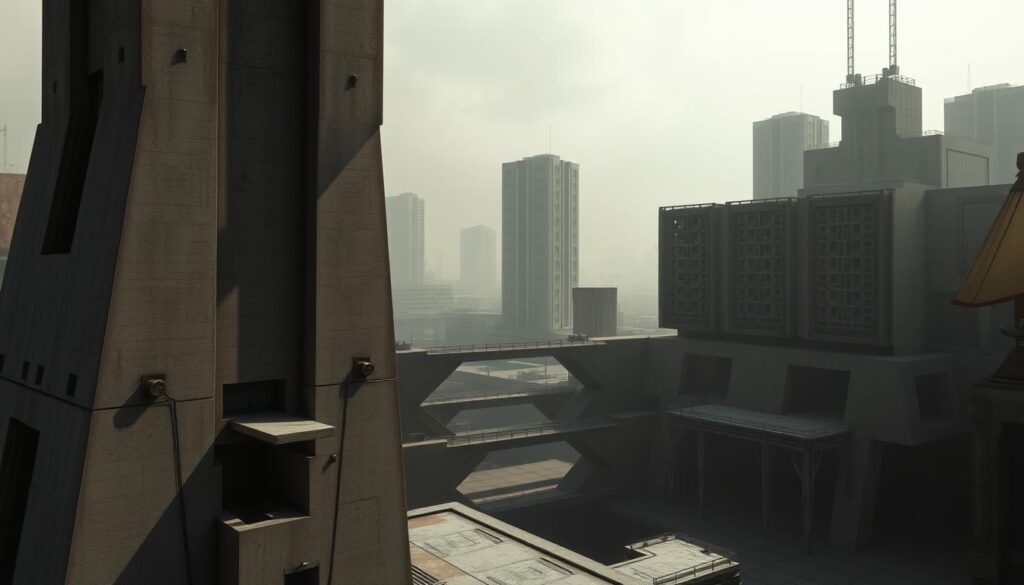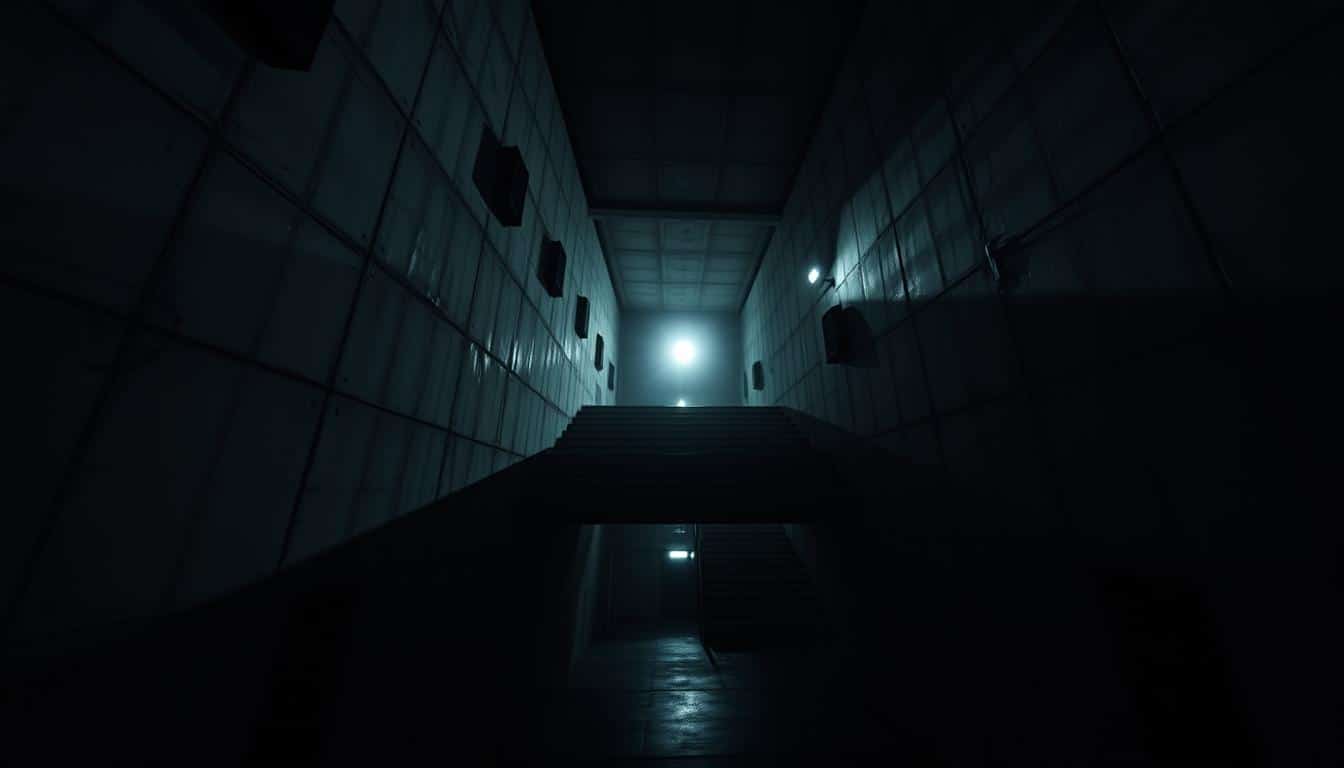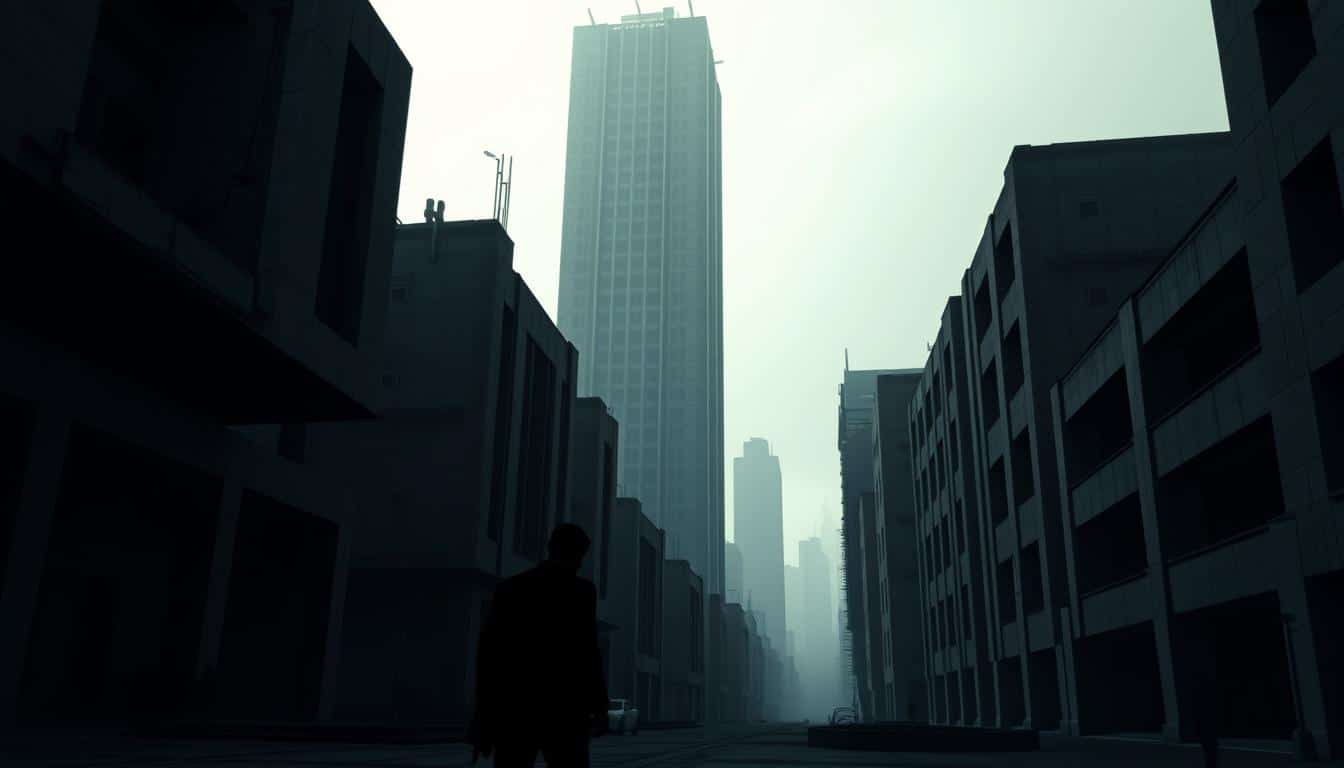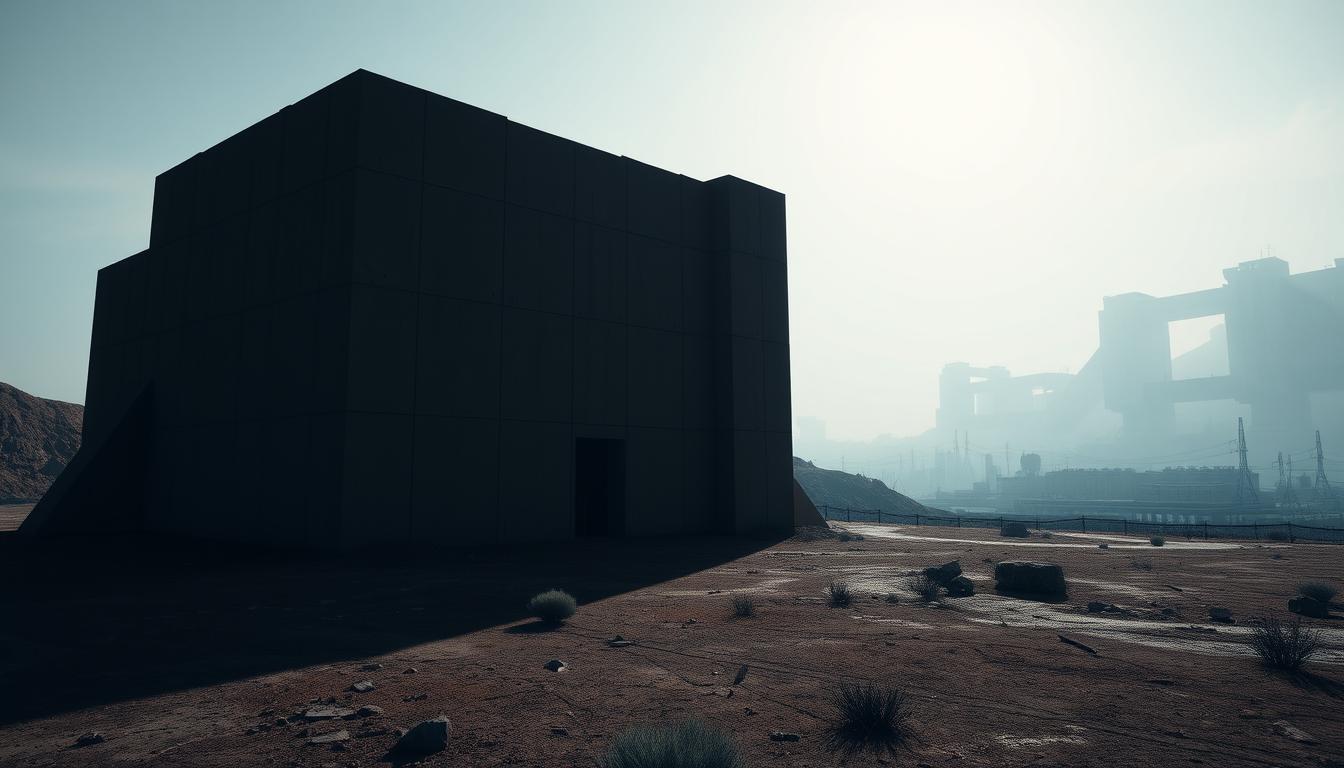Brutalism is well-known in architecture for its bold and simple looks. Now, it is making a splash in video game design. This discussion will dive into the psychological layers of games inspired by brutalism. It will look at how these strong architectural features affect the game’s story and play.
In video games, brutalist architecture takes on a new role. It does more than just shape the setting. It also plays a key part in how players feel and experience the game. We’re going to explore how brutalism in games is more than a design choice. It links games to their historical roots and deepens the mental and emotional connection players have with the game.
The Rise of Brutalist Architecture in Video Games
Brutalism in gaming has changed how we see video games. It introduces a simple yet bold look that pulls players in. This style began in the mid-20th century, highlighting function and strong statements in architecture. Now, game makers love using brutalist design to make unforgettable settings that improve gameplay.
“Dishonored” shows how brutalist design can improve games. The buildings are more than just backgrounds; they are key to the story and game mechanics. This encourages players to really use and understand the space around them. As more designers use brutalist architecture in games, they create worlds that make players feel more connected and invested.

The Core Elements of Brutalism in Game Design
Brutalism started in architecture but has made its way into video games. It brings core principles of brutalism like functionality, raw materials, and simple shapes. These key factors create a unique gaming experience by using stark visuals similar to real-life buildings.
In games, these architectural elements help build the game world. Designers focus on practical gameplay, putting the purpose of every action first. This approach helps players get more involved in the game’s environment and story.
The use of real materials, like concrete, adds reality and weight to the game settings. These designs do more than look interesting; they deepen the player’s emotional journey through the game. By combining these elements, brutalist game design stands out, offering players a new way to see and play games.
Psychological Depth of Brutalist-Themed Video Games
Brutalist-themed video games create a special bond with players. They immerse them in worlds of stark beauty and imposing buildings. This sets off deep emotional reactions, making the game more engaging.
Exploring Emotional Connections through Environment
Brutalist architecture’s harsh lines can make players feel alone and thoughtful. This deepens the impact of brutalist video games. Players exploring these areas may feel lonely or reflective, pushing them to think more about what they’re doing.
Concrete-filled and minimalist spaces push players to connect with the game’s story on an emotional level.
Player Experience and Immersion
How well a game’s world is built affects how immersive it is. In brutalist games, this interaction pulls players in deeper. They can explore and change their environment, making the story stronger.
This interaction between player choices and the game world makes the adventure more meaningful. It helps players get a deeper insight into the game’s message and the characters’ paths.
Aesthetic Theories in Brutalist Video Games
Brutalist video games are a powerful example in the world of gaming. They grab players’ attention with their unique building styles. They also use visual and sound designs that touch our hearts. The combination of sights and sounds is key to making the game’s atmosphere. This mix helps bring out deep emotions in games with big stories and ideas.
The Role of Visuals in Evoking Emotions
The look of brutalist games is very thought-out. These games are known for their simple shapes and plain textures. This style can make you feel many things, from missing the past to feeling on edge. The way these games are set up can change how players feel. It lets players connect with the game’s story. Using mostly one-color themes helps highlight the emotional journey. These examples show how telling a story through the environment is linked with gaming theories. They invite players to dive into a world that shows both beauty and hardship.
Sound Design and Its Impact on Mood
The mix of sight and sound in games is greatly influenced by the sound. The brutalist setting is made more real with carefully made sounds. Music that sets the mood and natural sounds work together to pull you in. These sounds build on the emotions the visuals start. They make feelings of being alone or stressed stronger. Looking at well-known games, we see how sound can boost what we see. This makes player interactions deeper and more fun. This combo of sight and sound shows how important sound is in setting the tone. It leads to a game play experience that is deeply engaging.
Brutalism as a Narrative Device
Brutalism in video games is not just for looks; it shapes the player’s experience. The stark, bold lines of brutalist buildings deepen the game’s mood and emotions. These buildings are more than just backgrounds. They are part of the story, affecting characters and choices.
Players find themselves in places that have their own stories. These are told through different materials, textures, and how spaces are arranged. This setup leads players to see how the game’s space is linked to its story. As players move through these geometric spaces, they discover the game’s deeper meanings. Some well-known games have used brutalism not only for its visual impact but to add layers to their stories.
When players dive into these carefully designed worlds, brutalism brings the stories to life. The building elements express feelings and ideas, connecting closely with the game’s narrative. This creates a special connection, making players think about the importance of these environments in the game’s larger story.
Case Studies: Notable Brutalist Video Games
This section sheds light on notable brutalist video games. We look at distinct titles to see how architecture influences gameplay and boosts player involvement. The games studied reveal the power of brutalism in digital media and its effect on gaming .
Dishonored: The Intersection of Architecture and Gameplay
“Dishonored” is a key game that blends steampunk and brutalist architecture. It drops players into a world where buildings play a huge role. The game uses big, bold structures and simple environments to drive the story and gameplay. Players’ choices are swayed by the brutalist architecture around them. This blend of design and decision-making puts “Dishonored” among the top brutalist video games.
Assassin’s Creed Odyssey: Atmospheres of the Past
“Assassin’s Creed Odyssey” captures the splendor of ancient Greece and the essence of brutalism. It brings to life historical settings, deeply drawing players into the story. Brutalist designs in the game create a world that moves players deeply. These architectural styles add depth to the gaming experience, showing how brutalism can deepen player immersion.
Psychological Themes Explored in Brutalist Video Games
Brutalist video games explore deep psychological themes. They tackle how we deal with sadness and loss. The games use buildings and design to make these feelings stronger, helping players get totally absorbed.
Coping with Grief and Loss
Some games really focus on dealing with grief. They use simple, strong designs to connect with players on an emotional level. Games like What Remains of Edith Finch and Gris use their look and feel to bring out sadness and desire, diving deep into the emotional side of gaming. The empty spaces mirror what characters feel inside, showing how hard grief hits.
Identity and Self-Exploration in Game Mechanics
Games with a brutalist theme make you think about who you are. They challenge players to look at themselves and their choices while playing. Dark Souls and Journey let players shape their own stories and find themselves. This mix of game play and design makes players feel closer to the characters and their paths.
Architectural Symbolism and Player Interpretation
In video games, the built environment is key in shaping the player’s experience and story. The use of brutalist structures can deeply affect how players see and feel about the game world. This interaction shapes their grasp of the story’s themes and the journeys of its characters. It shows the strong link between architecture and how a story is told.
The Influence of Built Environments on Game Narratives
Brutalism plays a big part in game stories as players move through designed spaces. The clear lines of brutalist architecture can highlight feelings of being alone, conflict, or comments on society. For example, a building that seems like a fortress could make players feel trapped. This backs up a story of fighting against something big and bad. Such design details make the story richer and push players to dig deeper by interacting with these architectural elements.
Players often find themselves thinking about what these spaces mean. This helps uncover the game’s deeper messages and emotions.
User Agency and Environmental Storytelling
How players see architecture is central to developing stories in games. As characters move and make choices, they create unique stories within the given spaces. Brutalist settings push players to look around and figure things out, tying exploration to the story’s unfolding. This means the narrative grows rich, woven by the players’ actions, affecting how they see the main plot. Architectural decisions spark a conversation between the player and the story. This makes the game more real and engaging.
The Impact of Brutalism on Player Psychology
Brutalism in gaming shapes player experiences in a big way. The harsh and often tough environments can make players feel strong emotions. This section looks at how brutalism’s psychological effects affect players in games. The design tied to this style can set the stage for tension and conflict. This makes the game’s emotional impact even stronger.
Building Tension and Conflict through Environment
Brutalist architectural elements add tension to gameplay. Players face large, unwelcoming spaces that might make them feel anxious or uncomfortable. This feeling can be used by game developers to make conflicts where the player’s heart beats faster as they move through these areas. Key factors in getting people interested include:
- The use of clear contrasts between light and dark, making it hard to see threats and navigate.
- Open, empty spaces that make players feel exposed, keeping them on their toes.
- Repeating structures that can make players feel stuck, increasing their anxiety and emotional involvement.
Games like “Doom” and “Dark Souls” use brutalist design well. They create experiences that need not just skill but also emotional strength. The psychological impact of brutalism comes through a mix of how the environment tells a story and gameplay that brings out strong feelings. This leaves a lasting impression on the player’s journey.
The Future of Brutalist Video Games
Gaming is changing, bringing exciting chances for brutalism in game design. Developers are using this style to change how we play games. This means games will look different and make us feel more. Indie and big studios are trying new things with this style. This could bring a new age of brutalist influence in games.
Emerging Trends in Game Design
Game design now uses brutalism’s bold looks to make games more interesting. We see:
- Minimalist Interfaces: Clean, simple menus focus on the game.
- Raw Aesthetics: Game worlds that show what they’re made of, pulling you in.
- Dynamic Soundscapes: Sounds that fit the game’s stark look, making it more real.
This style does more than look cool; it changes how we play.
Potential for Innovative Gameplay Experiences
Brutalism makes games that challenge and move us in new ways. Tough settings boost our feelings and make stories more interactive. Trying out these ideas could lead to:
- Unique Environmental Challenges: Players face hard obstacles that test them.
- Psychological Depth: Games that make us feel alone and strong hit harder.
- Collaborative Mechanics: Working together in tough settings.
This mix of art and play could give us games we’ll never forget. Using brutalism in games starts conversations about how games touch us. It’s key in deciding how gaming will look in the future.
Conclusion
Looking at brutalist gaming, it’s clear how combining brutalist architecture with video game design can deeply affect players. These stark, bare settings do more than just look interesting. They touch our feelings in a big way. This shows us that architecture does a lot more than just create the backdrop for games; it’s key to making the story come alive.
When game creators use brutalist themes, they open up new possibilities. They can make games that feel brand new and deeply involve the player. By diving into the emotional and mental aspects of these structures, game stories and interactions get richer. This makes the gaming experience more meaningful for everyone.
To wrap up, the link between building design and how we feel when we play games is important. It makes us see video games in new ways. Our talk reminds us to keep looking into how architecture affects our gaming experiences. This way, games that use brutalist styles will keep being important and exciting for a long time.



